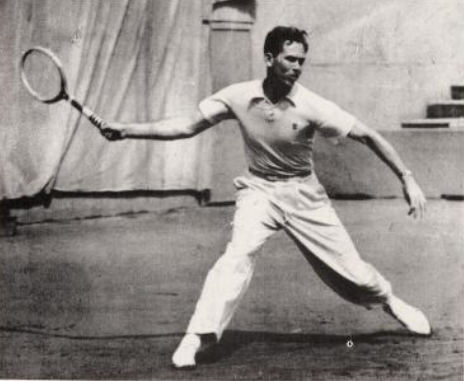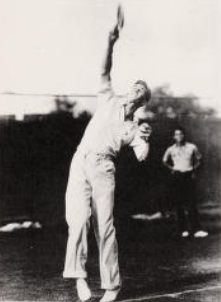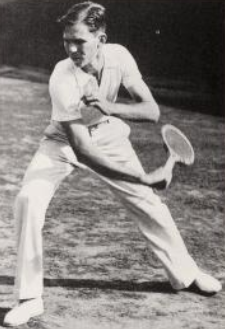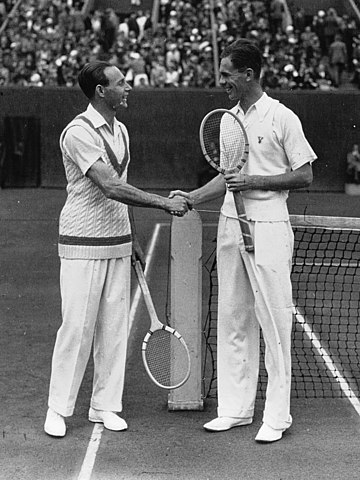In 2022, I’m counting down the 128 best players of the last century. With luck, we’ll get to #1 in December. Enjoy!
* * *
Ellsworth Vines [USA]Born: 28 September 1911
Died: 17 March 1994
Career: 1929-39
Played: Right-handed (one-handed backhand)
Peak rank: 1 (1932)
Major singles titles: 3
Total singles titles: 36
* * *
Ellsworth Vines sounds like a character out of a John Steinbeck novel. He looked like one, too. Standing six-feet, two-inches tall, he weighed barely 150 pounds. He didn’t walk, he ambled.
The word that came to everyone’s mind was “whipcord.” Vines didn’t give the impression that he was trying particularly hard. But his Continental-grip serve, propelled by a vicious snap of the wrist, resulted in–whip!–one of the most devastating deliveries of his era. Or any era.
When Elly made his first trip to Wimbledon, in 1932, he lost only two sets en route to the final. Facing British hope Henry “Bunny” Austin for the championship, the 20-year-old Californian crushed overheads so hard they bounced into the royal box. At match point, he struck his 30th ace of the day. The ball flew by so fast that Austin wasn’t sure whether it passed him to the right or the left. The 6-0 final set lasted all of ten minutes.
A London newspaper tagged it, “Murder on the Centre Court.” One Davis Cupper called the Vines game “terrifying.”
A Cleveland sportswriter saw Vines face Bill Tilden in 1934. He described the serve:
Vines just seemed to stretch, lazily it seemed, and toss the ball over his head. Back went that racket, a long, lean arm gripping it at the very end of the handle, up and over–and suddenly a spurt of white hit the court at Tilden’s feet.
In 1935, a Philadelphian, Dr. J.F. Strawinski, measured Elly’s serve with a device of his own design. It clocked in at 130 miles per hour–and that was a mere average of his ten fastest deliveries. Another apparatus said 122 mph. The exact number doesn’t matter. Vines, with a wooden racket and stricter foot fault rules, was cracking serves that would outpace many of today’s stars.
Oh, and his second-serve kicker was one of the best in the business. His peers rated it second only to that of Gottfried von Cramm.
The proof was in the results. In 1939, Elly still felt lingering effects of a shoulder injury, and his interest in tennis was waning. His serve was still virtually unplayable. In a 39-match series against Don Budge–some of them on clay–he averaged more than two aces per service game.
Vines was not the only monster server of his era; he wasn’t even the only one from Southern California. Johnny Doeg, just a few years older, hit nearly as hard, and he was left-handed. He rode his first-strike game to a Forest Hills title in 1930. Les Stoefen was a premier doubles player who joined some of Elly’s pro tours. Dr. Strawinski measured Stoefen’s serve at 131 mph.
There were two main differences between Vines and his fellow Californians. He possessed “a flat forehand that had to be seen to be believed,” wrote Jack Kramer in 1979. “It was without question the hardest forehand in the history of the game.”
Elly’s other advantage was an all-around athleticism that allowed him to steadily add to his arsenal. He played semi-pro baseball as a teen, went to college on a basketball scholarship, and joined the professional golf tour when he hung up his tennis racket. For a decade, he shored up one weakness after another, maintaining his position as the best player in the world until Budge dethroned him.
* * *
Vines packed more ups and downs into his short tennis career than most people could manage in a lifetime. His days as an amateur spanned barely more than four years.
Raised in Pasadena, he was a nondescript junior player until coach Mercer Beasley spotted him at age 14. Beasley took the spin out of Elly’s forehand and taught him the flat stroke that would barely skim the net. The youngster made his first trip East in 1930, when he was 18. He scored a few big wins, including upsets of Frank Shields and Frank Hunter for the New York Metropolitan Grass Court title.
Allison Danzig later wrote, “Vines at the peak of his form could probably have beaten any player who ever lived.” Praise like that usually carries an unspoken implication. When he wasn’t playing well, he was vulnerable. That was especially true in 1930.
The week after his Metro title, Elly repeated his victories over Shields and Hunter, then suffered a shock of a loss against soft-balling Sidney Wood, 6-2, 6-2, 6-0. The defeat both pierced his confidence and offered other players a game plan. He won only a couple more matches before returning to California.
“I guess I’m just a false alarm,” he said.
His next fifty-seven opponents would beg to differ.
Back in Los Angeles, Vines won five straight to take the title at the Pacific Southwest. He outlasted the reigning Wimbledon finalist Wilmer Allison and made quick work of George Lyttleton Rogers, the Irishman who had beaten him a month earlier at Forest Hills. When he went on the road again in 1931, his winning ways continued. He dropped only two decisions in his first 52 matches. The rest of the circuit quickly learned that soft-balling Elly no longer did the trick.
* * *
The Vines who returned to Seabright in 1931 was a different player. A year after the disastrous loss to Wood, he put on a display of both physical and mental fortitude, coming back from a two-set deficit against fellow fireballer Johnny Doeg.
Punditry was as hard then as it is today. Danzig, writing in the New York Times, marvelled at the 19-year-old’s maturity:
His lasting qualities, in spite of his thin frame, are to be attributed largely to his relaxed style of play. Vines has learned what it would pay many other young players to learn, that tournament tennis is too strenuous a game for any one who does not conserve his energies…. [He] appears to be out for an afternoon’s leisurely practice until the ball is put in play and even then he is not to be hurried.
John Tunis, the correspondent for the New Yorker, came to the opposite conclusion:
The boy has the strokes and the game of a great player, but he has yet to learn the lesson of how to conserve himself, how to reach the end and the important part of the season at the peak of his game. In view of his physical condition I very much doubt whether Vines has the stamina to carry him through the long grind of the Singles at Forest Hills.
“Four months of tennis on end,” Tunis wrote. “Think of it!”
An excess of tennis would soon prove Elly’s (temporary) undoing, but in 1931, Danzig was the better forecaster. Vines was fresh enough at Forest Hills to win six matches, including a five-set semi-final against Fred Perry–one of his four victories against the Brit that year. He defeated George Lott in the final to cement his place as the new number one American.
* * *
Vines limited his tournament play in 1932, but he was just as busy spearheading the United States team’s effort to regain the Davis Cup. Just to reach the Challenge Round and take on France for the title, the Americans needed to progress through four rounds. Elly went undefeated, knocking off Jack Crawford and Harry Hopman of Australia, then von Cramm and Daniel Prenn of Germany.
In between, he made his first visit to the All-England Club and waltzed through the Wimbledon draw. Elly lost seven games in the quarter-finals against hard-hitting Spaniard Enrique Maier, six in the semi-finals to Crawford, and six in the championship match, the 30-ace display against Bunny Austin.
All that could stop him was the combined efforts of France. The groundskeepers at Stade Roland Garros watered down the courts so that the Americans would have to cope with an even slower surface. The US had defeated Germany at the same venue, but von Cramm and Prenn didn’t have the crowd–or the linesmen–on their side.
Elly might have had a chance against the aging Jean Borotra in the opening rubber, even on such an unfriendly surface. But the battle was marked by a series of suspiciously Gallic line calls. Borotra played a tactically savvy match, keeping the Vines serve in play and conserving his resources for an all-out net attack in the fourth set. Henri Cochet made it two-nothing for the hosts with a four-set win over Wilmer Allison.
The American doubles team eked out a victory on day two, but Borotra sealed the championship by defeating Allison. From our vantage point ninety years later, it’s tough to know just how egregious the French officials were. Suffice it to say that on match point in the fifth set, Allison hit an unreturnable serve, and Borotra jogged to the net to congratulate him on the victory. Then the line judge called it out, and Borotra came back to win the decider, 7-5.
The only consolation for Vines was the dead fifth rubber. Both sides took the final match seriously, and with the Cup secure, the linesmen may have handled their duties more scrupulously. The American beat Cochet in five. On paper, Cochet was one of the few men with a game that could’ve troubled the Californian; his quickness and return of serve had the potential to blunt Elly’s weapons. But Vines won all three of their amateur encounters.
The two men next met for the 1932 US Championship at Forest Hills. This time, Vines needed only three sets. Cochet did plenty of running, but just as often, he didn’t bother. Danzig wrote, “It would have been as useless as to chase rainbows.”
Vines beat Cochet again at Wimbledon the next year. The Frenchman gave a capsule review: “Never saw anything like it.”
* * *
Vines turned 21 years old a few weeks after claiming his second Forest Hills title. He had played an enormous amount of tennis in two years, and he was about to play even more. Instead of going back to USC for the fall semester, he headed to Australia as part of a five-month tour.
A break would’ve been a better choice. Elly won just one of the three tournaments he played Down Under, losing in the quarter-finals of the Australian Championships to the unfamiliar double-handed backhand of Viv McGrath. He wasn’t thinking about a Grand Slam–the term wouldn’t even be coined until later that year–but it was an feeble start to the season nonetheless.
As the world’s leading amateur, he was already a prime target for pro tennis promoters. Bill Tilden was the reigning champ among the professionals, and though Big Bill was 40 years old, no one on that side of the divide could consistently challenge him. Vines could.
Before Elly went to Europe for Wimbledon and a crack at the 1933 Davis Cup, he reached a verbal agreement with Tilden to turn pro after the season. The trip was a failure. Vines lost a gripping Wimbledon final to Jack Crawford and dropped both singles rubbers in a Davis Cup tie against Great Britain. Even back home, he failed to pick up a single title on the East Coast swing. He lost in the fourth round at Forest Hills to Bryan “Bitsy” Grant, whose nickname signified both his stature and his usual chance of victory against an in-form Vines.
Some pundits assumed that Vines was stale, “over-tennised” after more than a year of non-stop competition. Tilden offered another explanation. The amateur association knew well that Vines had been approached to turn pro. He told the press he might consider it. So association officials pestered him throughout the European trip, concerned if he was thinking about it, if he had negotiated, if he had made a deal, and on and on. The mental strain left him unfit for top-flight tennis.
Whatever the reason, 1933 was a flop. To his credit, Tilden held up his end of the verbal bargain and gave Elly a lucrative deal that his recent results didn’t merit. Big Bill banked on his belief that Vines’s huge talent would allow him to turn it around.
* * *
Vines not only recovered, he became the best professional player of the 1930s. He defeated Tilden in 1934, then cleaned up against a mix of second-raters (including George Lott and Les Stoefen) in 1935 and 1936. He held off Fred Perry in 1937 and 1938, then made a respectable showing against Don Budge in 1939.
Professional records are not official and they remain incomplete to varying degrees. But we have more than enough to get the general idea. Here are Elly’s won-loss records for the matches I can document:
Year Wins Loss Win% 1934 50 19 72% 1935 71 17 81% 1936 90 13 87% 1937 34 33 51% 1938 53 38 58% 1939 38 42 48% Total 336 162 67%
With the exception of 1936, these are not eye-popping numbers by tennis standards. But there were no gimmes in pro tennis. No early-round warm-ups. The vast majority of these matches were against the next-best player in the professional ranks. The day after a tough match against Perry, he got to face Perry again. And again, for months on end.
Vines might have been even better than the numbers indicate. The 1937 duel with Perry was so close that it raised eyebrows. A tight series generated press interest and helped the gate, so professional tennis always had to dispel suspicions that the matches were fixed. They usually weren’t, and anyone who witnessed the battles in person could attest to it.
But Jack Kramer, who would later star in and promote his own tours, heard a different story:
[Promoter] Jack Harris … always told me that Elly carried Fred to make things look close, and sell more tickets. But whenever I’ve asked Elly to admit that, he’d change the subject.
Kramer seems to have believed it. For his 1979 book The Game, he imagined an alternate timeline in which the amateur and professional camps had never been divided, then made a list of his “open” Wimbledon and Forest Hills champions from 1931 to 1967. In reality, Vines won three majors. Kramer’s version gave him eleven.
* * *
Elly continued to develop as a pro. He adapted to indoor tennis to beat Tilden, and he worked out a steadier baseline game–including a bit of topspin on his famously flat forehand–to stay ahead of Perry.
Kramer is the best source for Vines’s own description of his game:
Elly told me that it was his strategy to play it safe off his weaker side, the backhand. He would just attempt to hit it deep; he would not go for placements with it. Then with his hard forehand drive, he would try and send the opponent from side to side. First he would hit crosscourt, then down the line, then crosscourt again. I asked him then: “What would you do if he got that shot back too?”
“Well, I would know that I was really up against a helluva player.”
Don Budge was a helluva player. He was one of the few opponents who could return the Vines serve with a proper groundstroke, not just a chip or a block. Budge’s youth and his ground game, combined with Elly’s shoulder problems, put the writing on the wall. Vines won 17 of 39 meetings on the pair’s American tour, but Budge took 15 of the next 20.
Vines had seen Tilden hang on past his prime, and he didn’t want to do the same. He couldn’t keep up with the new champion, and he was spending more and more time on the golf course. Aside from the occasional exhibition, he put tennis behind him, and he became a professional golfer in 1942.
While his golf game was never as strong as his tennis, it was enough to make him one of the greatest American two-sport athletes of all time. He reached the semi-finals of the PGA Championships in 1951 and twice finished among the top ten money winners on tour.
If nothing else, Ellsworth Vines could hit the living daylights out of a golf ball.



